From Greece to Copenhagen. The itineraries of two reliefs
- Gabriella Cirucci, arkivet.thorvaldsensmuseum.dk, 2023
This article illustrates the results of an interdisciplinary research project carried out at the Thorvaldsen Museum in collaboration with Gabriella Cirucci, Marie Sklodowska-Curie Fellow at the University of Copenhagen (SAXO Institute), as part of her research project “REFRAME. Greek Funerary and Votive Reliefs Reused for Display in the Ancient Mediterranean”, funded by the European Commission.
The research focused on two reliefs belonging to Bertel Thorvaldsen’s collection of ancient sculptures with the aim of tracing their itineraries through time and space, from their carving in an ancient Greek workshop right through to their musealization.
The results of this study were presented to the public in the exhibition “From Greece to Copenhagen. The itineraries of two reliefs”.
The following paragraphs present an outline of the Marie Sklodowska-Curie project “REFRAME”, along with a description of the interdisciplinary research project “From Greece to Copenhagen. The itineraries of two reliefs” and a summary of the main results and findings achieved in this study.
The REFRAME Project
“REFRAME. Greek Funerary and Votive Reliefs Reused for Display in the Ancient Mediterranean. A Long-term, Interdisciplinary, and Cross-cultural Approach” is a research project which is being carried out at the SAXO Institute at the University of Copenhagen by the research fellow Gabriella Cirucci under the supervision of Prof. Jane Fejfer.
The research project is funded by the European Commission under the Marie Sklodowska-Curie Actions, a funding programme whose main aim is to “fund excellent research and innovation and equip researchers at all stages of their career with new knowledge and skills, through mobility across borders and exposure to different sectors and disciplines”.
REFRAME focuses on reliefs sculpted in Greece from the sixth to the second centuries BCE that after exhausting their original function as gravestones in cemeteries, or as votive gifts in sanctuaries were reused and put on display in a new context.
Its main aim is to reframe the current understanding of these artefacts from a comparative, long-term, and cross-cultural perspective, drawing – and bearing – on different disciplines and fields of studies.
Why, and how, were old Greek tombstones and small votive gifts capable of affecting people in different cultural areas and periods from Antiquity right through to our times?
REFRAME will establish a new interpretive model capable of illuminating the impact of these artefacts in their original contexts as well as over time and space, from their origin right through to their musealization. Thanks to its long-term, cross-cultural, and comparative approach, this research will provide us with new and in depth knowledge of the Greek and Roman attitudes toward and interest in antique artefacts, achieving a more inclusive understanding of ancient reuse, collecting, and antiquarianism.
However, this project will also disclose new opportunities for comparative research in other historical periods and cultural areas, providing new scientific methods, tools, and networks to bridge ancient and contemporary attitudes toward and interest in antique artefacts.
Further, this project aims to bring knowledge to the public of the itineraries of these reliefs over time and space, by allowing museum visitors to experience and understand these objects – and re-empowering these reliefs to affect people with their presence and materiality, as they have done throughout their history.
The REFRAME Project at Thorvaldsens Museum
The REFRAME project deals with marble reliefs that were already perceived as “antique” objects in Greco-Roman antiquity. Indeed, many of the Greek and Roman antiquities that we see in Museums nowadays have had complex itineraries through time and space. They were not simply produced for a specific purpose, then been discarded and buried before being rediscovered in modern times. Already in antiquity some of them went through many transformations, being sometimes moved to different places and becoming part of new assemblages. This also goes for Thorvaldsen’s ancient sculptures.
These arrived in Copenhagen as part of the collection of antiquities that Thorvaldsen collected over time in his house in Rome, and wished to bequeath to his hometown as part of his personal museum.
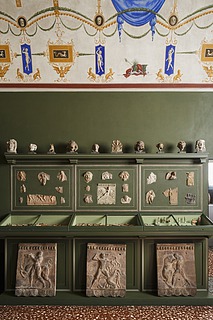
Thorvaldsens Museum. Room 39. Photo: Jakob Faurvig.
The museum display highlights these sculptures as they became part of Thorvaldsen’s imagery and daily life and preserves them as they became Danish cultural property at his bequeath.
The exhibition “From Greece to Copenhagen. The itineraries of two reliefs” brings to the fore the itineraries of two of these marbles, which were given special care and attention, as they are in the contemporary museum, not only in Thorvaldsenʼs time, but already in antiquity.
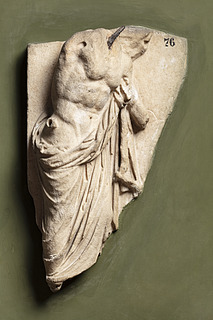
Fragment from a votive relief with the god Asclepius H1476. Photo: Jakob Faurvig.
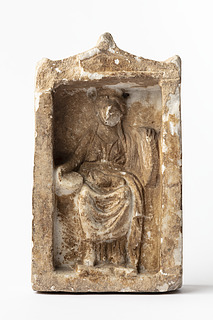
Miniature relief in the form of a small temple with the goddess Cybele H1467. Photo: Jakob Faurvig.
This exhibition aims to trace the itineraries of these reliefs over time and space, in order to actualize the different times and places when and where they were active as well as to reactivate the different relations among people, other objects, and spaces they were – and are – part of.
Fragment from a votive relief with the god Asclepius
The male figure leaning on a staff represents the god of medicine Asclepius, as we know him from a type attested by statues and on coins, as on a Hellenistic silver tetradrachm from the island of Kos now in Berlin dated to 170-160 BC.

Hellenistic silver tetradrachm. Munzkabinett, Staatliche Museen zu Berlin, Inv. No. 1821175. Photo: Reinhard Saczewski.
The fragment belonged to a larger relief, originally dedicated to Asclepius by a worshipper for asking or thanking him for healing. In similar reliefs, the god is frequently depicted with the goddess of health, Hygeia, or with other gods, and a family of worshippers is often part of the scene.
The relief was made in Greece in the fourth century BCE, as its style and workmanship suggest, to be dedicated in a sanctuary. However, its current state of preservation also show that at some point in time, after being damaged by a natural or human event, it was considered worthy of being restored.
The metal pin preserved in the neck as well as the dowel hole visible in the right shoulder of the figure may be read as traces of ancient repairs. The parts that were broken off, namely the head and the right arm of Asclepius, were therefore restored or replaced already in antiquity.
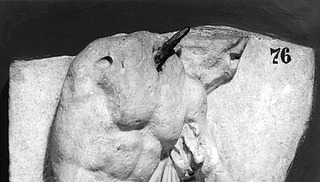
Fragment from a votive relief with the god Asclepius H1476, (detail). Photo: Ole Woldbye.
We are not sure if the relief was restored to be shown in the same location where it was originally dedicated, or in connection with being moved to another place. Some votive reliefs were relocated in later times very far from their original sites in Greece, as it is shown by some exemplars found in Roman houses, such as the Hellenistic relief with Aphrodite and Eros, most likely translocated from a Greek sanctuary, found inlaid in the peristyle’s south wall of the House of the Golden Cupids in Pompeii, the city destroyed in CE 79 by the eruption of Mount Vesuvius.
Ancient shipwrecks attest that old sculptures were traded with the purpose of being reused. Votive reliefs dating to the fourth century BCE were found in a shipwreck near Mahdia (off the coast of Tunisia), where a ship foundered while carrying statuary and luxury goods from Greece in the early first century BCE.
This also bears on the question regarding where the relief was discovered and how it came into Thorvaldsen’s collection. We have very little information regarding how and from where Thorvaldsen acquired his antique marbles. In the current state of knowledge, we cannot say whether he got the piece directly from Greece, perhaps from one of his acquaintances who travelled there in the early nineteenth century, or from another site (perhaps in the proximity of Rome, or in Southern Italy) where the relief was exported in antiquity.
Miniature relief in the form of a small temple with the goddess Cybele
This relief in a form of a small temple depicts the mighty goddess Cybele, whose cult is believed to have spread to the ancient Mediterranean world from Phrygia (Western Anatolia, modern Turkey). In Greece, the goddess was also often venerated as Mother of the Gods. The goddess is represented seated on a throne, wearing a sleeveless chiton and a himation, with a polos above her head. On either side of the polos are two drill-holes, located at the same height, which must have served for the insertion of a metal element, such as a diadem or a crown. The left leg is carried forward and the feet are resting on a footstool. The right forearm is extended and the hand holds a patera; the left arm is held adjacent to the body, with the left hand resting on the tympanum. A small lion is crouched on the goddess lap.
The type and iconography of this relief brings it close to a large series of votive reliefs in the form of a small temple that were produced in Athens and in the nearby region of Attica from the fourth century BCE to the late imperial age. Within this chronological range, the relief in Thorvaldsen Museum can be dated between the Hellenistic age and the early Roman Imperial age. Very important discoveries regarding the itinerary of this piece were made in connection with this exhibition.
New data were acquired regarding the start of this itinerary. A very small chip of marble was cut off from the back of the relief to perform laboratory analyses in order to determine the provenance of the marble used to carve the relief. The sample was taken by conservator Sofie Stærbo from Museum of Copenhagen and the analyses performed by the geologist Domenico Poggi in collaboration with Lorenzo Lazzarini, retired professor of Petrography at the Istituto Universitario di Architettura in Venice (IUAV).

This photo, taken with a polarized microscope, shows the microstructural features of the stone. Photo: Domenico Poggi.
The results indicate that the marble was quarried on Mt. Pentelicus near Athens. This suggests that the relief most likely was produced in this city or in its region (Attica).

The quarries on Mount Pentelicus. Engraving from Edward Dodwell, A Classical and Topographical Tour Through Greece: During the Years 1801, 1805, and 1806 (London 1819, Vol. 1, p. 500).
New information came also from the analyses of the polychromy of the relief, which were done in collaboration with senior conservation scientist Jens Stenger and senior researcher Cecilie Brøns of the Ny Carlsberg Glyptotek. The research questions concerned the itinerary of the relief and whether the analyses could provide data on its reuse, for example by identifying traces of ancient repainting of the relief, of later interventions, such as remains of ancient mortar used to install it in a wall.
The relief was first investigated with multispectral imaging, a non-invasive methodology useful to identify pigments and other substances on the objects surface. Traces of ancient red paint were documented in Cybele’s hair and the VIL imaging (Visible light induced infrared luminescence) revealed the presence of Egyptian blue, a pigment that was most likely used in the ground layer. An unexpected result came from the UVF (UV-induced fluorescence) imaging, which revealed an ample area of the lower right side of the relief covered by an organic substance having a characteristic orange fluorescence that is a diagnostic feature of shellac, a natural resin used in modern restoration and consolidation practices. On the back and sides, a blue fluorescing material appeared as possible remains from a previous installation of the relief.
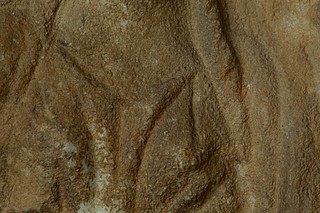
Red paint on Cybele’s hair in visible, raking light. Photo: Jens Stenger.

UVF image showing the orange fluorescing material. Photo: Jens Stenger.
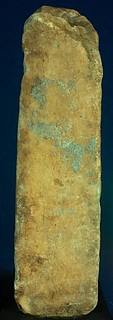
UVF image of the right side showing the blue fluorescing material. Photo: Jens Stenger.
In a second phase, four micro-samples of the surface were taken and investigated with Fourier transform infrared spectroscopy (FTIR) to gain more information. Unfortunately, the results were not able to provide new knowledge on the ancient polychromy of the relief nor to identify the blue fluorescing material. Also, the presence of shellac was not detected by these means, most likely because it was applied in a very thin layer.
However, these analyses revealed precious information about the itinerary of this relief, especially with regard to its conservation history, by suggesting that at some point in time shellac was most likely used to consolidate the surface of the relief. Without the new data, this segment of the relief’s itinerary would have remained unknown, since no trace of this is visible to the naked eye, and no modern intervention on the piece is documented in the museum archives.
Originally set up in sanctuaries or in private houses, some of these reliefs were appreciated, cared for and reused centuries after their creation, especially in Late Antiquity. The peculiar execution of the base of the relief, which seems to have been cut back in a later time, perhaps to be reused in a different setting, seems to suggest that this was the case also with the relief in Thorvaldsen Museum.

The base of the relief with Cybele H1467, with the modern hole made for its mounting on the current support. Photo: Jakob Faurvig.
A very good comparison for this relief is the one, of the same type and iconography, now displayed in the Acropolis Museum of Athens.

Plan of the “House of Proclus” as it is reproduced in the pavement of road Dionisiou Areopagitou in Athens, where it was excavated. Photo: author.
This relief, dating to the fourth century BCE, was found reused in the so-called “House of Proclus” on the South slope of the Athenian Acropolis, identified as the house and school of the Neoplatonic philosopher Proclus, where old marbles were reused for display in a domestic shrine in the fifth century CE.
The available information on the formation of Thorvaldsen’s collection of antique marbles does not allow us to reconstruct how the relief was acquired, nor to identify where it was found. In the current state of knowledge and on the basis of the new data on the marble’s provenance, however, it is possible to make some conjectures. Although these types of reliefs are also attested outside Athens and Attica, in mainland Greece, in the Greek islands and in other sites in the eastern and western Mediterranean, the most plausible hypothesis in light of the comparisons identified and in view of the small size and sculptural execution of the relief is that it was originally intended for a local sanctuary or domestic shrine and was therefore found in the city of Athens or in a village in Attica.
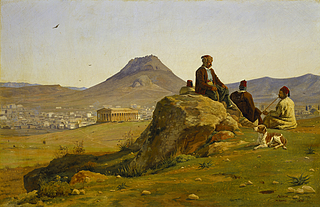
Martinus Rørbye (1803-1848): View of Athens from South-West, 1836. Thorvaldsens Museum B286. Photo: Ole Woldbye.
It is worth mentioning, in this regard, the observations made by the German archaeologist Ludolph Stephani (1816-1887) on the conspicuous number of reliefs with Cybele of this type that he had the opportunity to see at the time of his trip to Greece in 1842-1843. In particular, the scholar described how common it was to come across this type of monument not only in public collections and private houses in the city of Athens, but in almost all Attic villages, pointing out that he was not, however, aware of any cases outside of Attica. To this region, therefore, Stephani believed that two specimens that arrived in Nordic collections via Italy should also be attributed, namely the relief in the Thorvaldsen Museum and a relief described by Eduard Gerhard in the Antikensammlung in Berlin.
Regarding its entry into Thorvaldsen’s collection, it cannot be excluded, as suggested by Jane Fejfer and Torben Melander, that the relief was acquired through Peter Oluf Brøndsted. In particular, the scholar had travelled to Greece between 1810 and 1813. In 1823 he left his collection of ancient books and coins on deposit at the sculptorʼs Roman studio as collateral for a loan, which later became part of Thorvaldsenʼs estate due to the failure to repay the debt.
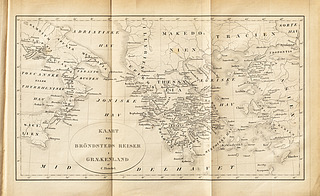
Map of Brøndsted’s travels to Greece from N.V. Dorph, Brøndsteds Reise i Grækenland i Aarene 1810-1813 (Copenhagen 1844).
The dense network of relationships Thorvaldsen had with leading antiquarians and archaeologists active in Athens and Greece in the first thirty years of the 19th century, as well as the dynamism and variety of the antiquarian market to which the sculptor had access in Rome, leave open, however, the possibility that the relief may have also arrived in the collection through other channels.
The interdisciplinary research project “From Greece to Copenhagen. The itineraries of two reliefs” created a fruitful synergy between different Institutions, bringing together researchers and professionals from different disciplines and sectors in Denmark and abroad. Although the study could not fill in all the gaps in our knowledge of the itineraries of the two reliefs under investigation, many important findings were achieved as a result of this collective effort. Thanks to the precious collaboration of the Responsible for the Antique Collection Kristine Bøggild Johannsen, the Head of PR & Communication Maria Horn Rasmussen, the Responsible for The Thorvaldsens Museum Archives Kira Kofoed, and the staff of the Thorvaldsen Museum, the results of this study were presented to the public in the exhibition “From Greece to Copenhagen. The itineraries of two reliefs” from May 25 to August 28, 2023 and made available online an open access through The Thorvaldsens Museum Archives.
Works referred to


Last updated 07.08.2023